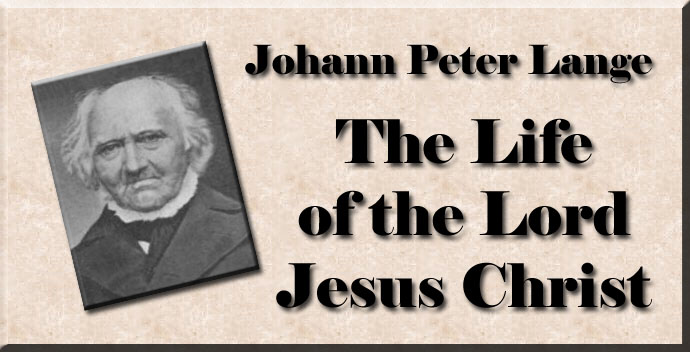
The Life of the Lord Jesus Christ
By Johann Peter Lange
Edited by Rev. Marcus Dods
VOLUME IV - THIRD BOOK
THE LIFE OF THE LORD JESUS UNFOLDED IN ITS FULNESS,
ACCORDING TO THE VARIOUS REPRESENTATIONS OF THE FOUR EVANGELISTS.
Part III
THE GOSPEL ACCORDING TO LUKE; OR, THE REPRESENTATION OF THE LIFE OF JESUS CHRIST SYMBOLIZED BY THE FORM OF A MAN.
|
SECTION IX. THE SECOND STAGE IN THE PILGRIMAGE OF JESUS. HE FIXES HIS ABODE AT CAPERNAUM. (Luke iv. 31-44.) The second stage of the wanderings of Jesus was Capernaum, a city in Galilee (Upper Galilee).1 Here also He appeared in the synagogues on the Sabbath-days, and taught. And here His audience felt that His word was in power, without taking offence at His lowly origin. Therefore also did Capernaum become a chief scene of His mighty works. On a previous occasion He must have performed miracles in this place, as has been stated. Hence we may explain the fact, that here He was already an object of terror to those who were demoniacally possessed. That He was so, is proved by the healing of a demoniac in the synagogue at Capernaum, which Luke also narrates. The Evangelist characterizes the demoniac more exactly — he had the spirit of an unclean devil. He distinguishes thus between the demon himself in his individuality, and his spirit. This seems to indicate that the patient was possessed by the demon in the joint action of his entire spiritual being. The words with which the demon received the Lord, and which are also narrated by Mark, he uttered, or rather cried out, with a loud voice. In this case of healing occurred the singular circumstance, that during the paroxysm of recovery, the demon suddenly dragged the patient into the very midst of the assembly, without, however, doing him any injury. This may have helped to increase the astonishment of the people at the power of Jesus over devils. The second miracle consisted in the cure of Peter's wife's mother, who had been taken with a great fever, Jesus healed her, bending over her and rebuking the fever. In this case also a cure took place by delivering the spirit of the sufferer from the ban of sickness. In the numerous cures which Jesus effected on the sick, who were brought to Him after the sun was set. He systematically employed the laying on of hands. 'He laid His hands,' we are told, 'on every one of them, and healed them.' From these cases of healing we must distinguish the casting out of devils, who came out of many. He rejected the honour attempted to be given Him by the demoniacs, who proclaimed Him to be the Son of God. He rebuked them, suffering them not to speak: they knew that He was the Christ. On the following morning, when the Lord departed into a desert place, a great multitude of people went after Him, We learn also what their purpose was: they wished Him to stay, and not depart from Capernaum. They thus formed a marked contrast to the people of Nazareth, who had cast Him out from their city. He however declared that He must proclaim the Gospel of the kingdom in other cities also, being thereunto sent. On this He commenced His journey through Galilee, and preached everywhere in the synagogues. ───♦─── Notes 1. The description of the remarkable circumstances attending the healing of the demoniac, and of the conduct of our Lord in the recovery of Peter's wife's mother, is quite after the manner of Luke. It is also characteristic of the Evangelist to notice the multitude of people who sought the Lord in the desert place, and urged Him not to depart from Capernaum; whereas he makes no mention of Simon, who was the leader on that occasion. 2. That the Evangelist does not take advantage of every opportunity to oppose the Judaizers, is shown by the circumstance that he does not (ver. 32) compare the doctrine of Christ with that of the scribes and Pharisees, as is done by Mark. He likewise omits (ver. 42) to mention that Jesus prayed in the desert place; so that the remark, that he delights on every occasion to represent Christ as praying, must be corrected. In the account of the healing of Peter's mother-in-law, he passes by the circumstance that Jesus took her by the hand and lifted her up. 3. Schleiermacher accounts for the circumstance that Simon is here only incidentally mentioned, and in this manner is introduced for the first time, by the hypothesis, that Luke composed his narrative from memoranda. But it may be also explained from the fact, that the Evangelists wrote for readers to whom the general outlines of Gospel history, and especially the names of the disciples, were already known. Schleiermacher is of opinion that the occurrence, V. 1-11, must necessarily have preceded the healing of Peter's mother-in-law; in like manner Gfrörer (p. 126). And with regard to the unprefaced remark, διηκόνει αὐτοῖς, see Ritschl (p. 77). These words are, however, introduced by the previous ἠρώτησαν αὐτόν, &c. 4. The 44th verse is apparently the concluding formula of a narrative, as it anticipates in a general form that which is first introduced by the following section.
|
|
 |
 |
|
1) See above, ii. 67. Luke, as well as Matthew and John, seems to be acquainted with the currency of the name Galilee for Upper Galilee.
|
|
-
Site Navigation
 Home
Home What's New
What's New Bible
Bible Photos
Photos Hiking
Hiking E-Books
E-Books Genealogy
Genealogy Profile
Free Plug-ins You May Need
Profile
Free Plug-ins You May Need
 Get Java
Get Java.png) Get Flash
Get Flash Get 7-Zip
Get 7-Zip Get Acrobat Reader
Get Acrobat Reader Get TheWORD
Get TheWORD